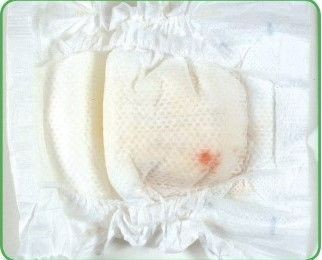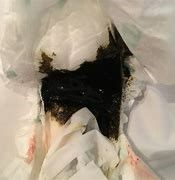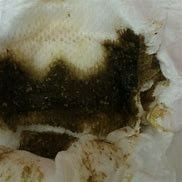Try putting the back of your hand on the baby’s tummy or back. This will tell you if they are hot or cold. It is common for babies to have cold hands and feet. Too help prevent over heating, avoid over wrapping with too many layers.
Fever in babies less than 90 days of age is much more likely to be due to a serious infection requiring urgent treatment compared to fever in an older child. For this reason, all children under 90 days of age with a temperature above 38°C / 100.4°F should be urgently reviewed by a healthcare professional. The only exception is if they have a fever in the 48 hours following their first set of vaccines (given at 8 weeks of age) – in this situation, it is OK to give them paracetamol without seeking medical advice if your baby is otherwise well.
Please click here for more information.
| Happy | Your baby should feel warm to touch. |
| Not sure | If your baby feels hot or cold try adding or removing a layer of clothes or blankets. |
| Unhappy | Seek immediate advice from your doctor if your baby feels hot after you have removed some layers OR if your baby's body remains cold. |
*The midwifery team will transfer care to the health visiting team within the first month of your baby being born.
It is common for newborn babies to make all sorts of sounds, from occasional snorts to grunts, gurgles to whistling.
It is common for newborn babies to make all sorts of sounds, from occasional snorts or grunts, gurgles and whistles. Babies normally breathe at a faster rate than adults and older children. It is normal for a newborn baby to take slight pauses in their breathing for a few seconds, or to breathe rapidly for a short period. By 6 weeks of age they should have a more regular breathing pattern.
Sometimes a baby’s breathing rate may increase for a longer period of time if they are unwell and you may also notice they are working harder to breath. For babies, the most tiring thing they do is feeding, so this can be the first time you notice them struggling to breathe. If they are too breathless to feed, they need to be seen urgently by a healthcare professional.
Please click here for more information.
| Happy | It's normal for newborn babies to take slight pauses in their breathing lasting for a few seconds, or to go through short periods of rapid breathing. Babies tend to develop a more regular breathing pattern by 6 weeks of age. |
| Unhappy | If your baby is struggling to breathe (constantly rapid breathing rate above 70 breaths per minute, flaring of the nostrils, making a grunting noise every time they breath out or too breathless to feed), or if they are going blue (especially their tummy, lips or tongue), you need to call 999 for an ambulance. |
*The midwifery team will transfer care to the health visiting team within the first month of your baby being born.
In the early days your baby might have some involuntary movements and may appear very jumpy – this is normal. It is common for them to sneeze, stretch and hiccup.
| Happy | They will be able to grasp your hand and will enjoy touching and stroking. |
| Not sure | Your baby should never be floppy or stiff for a prolonged period. Call a doctor if this applies to your baby, or if your baby’s shaking is rhythmic and doesn’t stop when you touch it. If you are unable to wake your baby, call 999 for an ambulance. |
| Unhappy | Your baby should never be floppy or stiff for a prolonged period. Call a doctor if this applies to your baby, or if your baby’s shaking is rhythmic and doesn’t stop when you touch it. If you are unable to wake your baby, call 999 for an ambulance. |
* The midwifery team will transfer care to the health visiting team within the first month of your baby being born.
Over 50% of newborn babies will develop a condition called neonatal jaundice. This is where their skin appears yellow. Regular feeding and exposure to daylight (being careful to avoid direct sunlight) will help to natually reduce the bilirubin levels causing your baby's skin to look yellow. Most commonly jaundice will not cause your baby any problems, however, if you have concerns that your baby is reluctant to feed, sleepy and difficult to wake please the information in the link provided below.
Please click here for more information.
| Happy | Your baby should be a normal skin tone. Babies may have hands and feet that are blue for about 24 to 48 hours after birth. |
| Not sure | If your baby is yellow but waking for feeds, feeding well and having wet and dirty nappies, contact your midwifery or health visiting team* who will monitor your baby closely. |
| Unhappy | Call your midwife or your health visitor* if your baby isn’t feeding well, is sleepy and not having wet and dirty nappies. They will need to assess your baby today. |
* The midwifery team will transfer care to the health visiting team within the first month of your baby being born.
It is normal for babies to have poor control over their eyes and appear cross eyed at times. Eyes look grey - blue, or brown in colour. They will develop their eye colour from six to 12 months.
Sticky eyes are common in newborn babies while their tear ducts are developing. You may see a sticky white or yellow discharge in the corner of one or both of your baby’s eyes, which may cause the eyelashes to stick together. This is caused by a narrow or blocked tear ducts, which generally open up and begin draining normally within the first few months of life.
Sticky eyes are not the same as conjunctivitis; conjunctivitis affects the outer coating layer of the eye and inner surface of eyelids, which in babies may be caused by bacterial or viral infections that they may have picked up during or after birth. The signs of conjunctivitis include a yellow/green discharge and redness and swelling of the eye(s). If you notice this contact your GP as your baby may need antibiotic eye drops. Infection can be passed on easily, so wash your hands and use a separate towel for your baby.
Please click here for more information.
| Happy
|
Your baby can have a small amount of discharge from their eyes. This is normal and needs to be cleaned with cool boiled water and cotton wool. |
| Not Sure
|
If there is a lot of discharge clean your baby’s eyes regularly and contact your midwifery or health visiting team*. |
| Unhappy
|
If your baby’s eyes look red and swollen call your doctor. This could be a sign of infection. |
* The midwifery team will transfer care to the health visiting team within the first month of your baby being born.
If your baby’s mouth is moist it means he/she is feeding well. You might even notice a blister on their top lip, which may even be present from birth. This is due to sucking and is normal.
Please click here for more information.
| Happy
|
A white tongue is normal after a feed. |
| Not Sure
|
If you see white spots in your baby’s mouth which do not disappear in between feeds, contact your midwife or health visitor*. |
| Unhappy
|
If the mouth is dry and your baby isn’t feeding well, call a midwife or health visitor* urgently. |
* The midwifery team will transfer care to the health visiting team within the first month of your baby being born.
It may feel that you are feeding your baby all the time. However, the frequency with which your baby feeds changes as they get older, please discuss this with your midwife or health visitor*.
| Happy
|
A well fed baby will be content during and after a feed and have wet and dirty nappies. |
|
Not Sure
|
If you have any feeding concerns, visit a breastfeeding support group or call your postnatal coordinator who will contact your midwifery or health visiting* team. If your baby is vomiting up a lot of milk, you should also inform your midwife or health visitor*. |
| Unhappy
|
* The midwifery team will transfer care to the health visiting team within the first month of your baby being born.
The contents of your baby’s nappy changes from day to day in the beginning. Breast fed babies often poo after every feed. You should expect:
- Day one to four: Baby’s nappies are usually black/green in colour. It can look like thick tar or marmite!
- Day four to seven: Your baby’s nappies will start to change colour from black/green to yellow.
- Day seven onwards. A baby’s nappy will be yellow. It will be soft and seedy if you are breastfeeding, or look like play dough if your baby is formula fed.
Wet nappies
The number of wet nappies you will expect to find changes in the amount of urine (wee) that you see over the first 7 days. Below is a guide to help you decide if your baby is passing enough urine (wee).
Day 1-2
2 or more wet nappies in the first 24-48 hours. The nappy will not feel heavy
You might see a small brick dust coloured mark in the nappy – urates- which should be smaller than a 5p piece
Day 3-4
3 or more wet nappies per day. The nappies start to feel heavier than before
Day 5-6
5 or more wet nappies per day. The nappy will feel heavy. If you want to check this then take a clean nappy and pour 3 tablespoons or 45mls of water into it. Pick it up – this is how a ‘heavy’ nappy should feel
Day 7 onwards
6 or more wet nappies per day
Urates
Urates, sometimes known as brick dust because that’s what it looks like: tiny orange or pinkish crystals. They are harmless: they are salts in the urine, and tend to show up in the very early days. Most babies will pass them once only. They can be a sign your baby needs a little help to feed more often or more effectively. Ask your midwife.

Pseudo Menses or False Periods
False menstruation or pseudo menstruation is harmless. It is a very light bleed from the vagina in some baby girls. It comes from the effects of your own hormones on her system, and it soon stops.

Nappy Wetness Indicator
Some nappies include a line which indicates when the baby has passed urine. This can help parents to know how many wet nappies the baby has had. Click here if you are worried about how much your baby is peeing.

Dirty Nappies
Dirty Nappy Day 0-1
The first baby poo is thick and black/green and very sticky. There might be several nappies that look like this or just one or two.

Dirty Nappy Day 1-2
There will still be the black poo for a couple of day but it will start to get a bit more green and less thick.

Dirty Nappy Day 2-3
As the milk starts to travel through your baby's tummy you will start to see the poo change to a green/brown colour and it will start to have little bits that look like seeds in it.

Dirty Nappy Day 3-5
Once the baby is feeding more you will find the poo turns a brown colour and is quite loose. It will continue to have little bits in it that look like seeds and will have at least 2 dirty nappies a day

Dirty Nappy Day 7 onwards
Exclusively breast fed baby. The poo will turn very yellow with small 'seedy' bits in it. It can be very watery which is normal. Some baby’s poo at every feed and all babies should pass at least 2 dirty nappies in 24 hours, at least £2 coin size, yellow and runny. If your baby is pooing less or you have any concerns please contact your health visitor, visit your local child health clinic or attend an infant feeding group to check your baby is feeding well and that they are gaining weight.

Formula milk fed babies: Some baby’s poo more often but usually once a day as a minimum. If your aby is feeding well and gaining weight then there is no cause for concern.
If your baby is struggling to have a poo and is constipated, please phone your Health Visitor for advice.
Click here for more information if you are worried about your baby's poos.
Click here for more information on Nappy Rash
| Happy
|
Babies will normally have several wet nappies a day. Some baby girls can have a small bleed or a discharge from their vagina. This is because of maternal hormones and usually only lasts a few days. You may even notice a yellow or dark orange urine stain in the nappy. This is normal. |
| Not Sure
|
If you are worried that your baby has not passed much urine (wee) you should feed them frequently. Put a little cotton wool in their nappy and you will know if they have passed urine. |
| Unhappy
|
From day 6 your baby should be having at least 6 heavy wet nappies in a 24 hour period. If you are concerned your baby is not passing enough urine (wee) contact your midwife, health visitor, the 111 service or your GP. |
* The midwifery team will transfer care to the health visiting team within the first month of your baby being born.
The umbilical cord will start to dry out and will usually fall off by the time your baby is two weeks old. The cord needs cleaning with cool boiled water and drying afterwards.
Click here for more info including pictures of what your baby's cord should look like.
| Happy |
The cord can be sticky underneath, this is normal. There may be a spot of blood when the cord falls off. This is normal. |
| Unhappy | If you notice signs of infection, such as swelling, heat, redness and a smelly discharge contact your GP. |
* The midwifery team will transfer care to the health visiting team within the first month of your baby being born.
It is normal for your baby to have dry skin. Flaking is common and usually lasts 1-2 weeks. Babies under 4 weeks should be bathed in water only. This does not need to be every day, every 2-3 days is enough.
Not sure? If your baby's skin is very dry, speak to your health visitor or pharmacist.
Unhappy? If the skin is itchy, sore, uncomfortable or broken contact your health visitor, pharmacist or GP.
| Happy
|
Wash your baby with water. Avoid using cleansing products. |
| Not Sure
|
If your baby's skin is very dry ask your midwifery or health visiting* team for advice at your next appointment. |
| Unhappy
|
* The midwifery team will transfer care to the health visiting team within the first month of your baby being born.
Baby buddy
Baby Buddy is your personal baby expert who will guide you through your pregnancy and the first six months of your baby’s life. It has been designed to help you give your baby the best start in life and support your health and wellbeing.
For more information and to download the app - click here
Thames Valley & Wessex Neonatal Operational Delivery Network of hospitals
This app includes information for families of premature and sick babies, with key information about each hospital and unit available.
Where should you seek help?
- If it is non-urgent, speak to your local pharmacist or health visitor.
- If your child has any of the above features, urgently see your GP. For an urgent out-of-hours GP appointment, call NHS 111.
- You should only call 999 or go to your nearest A&E department in critical or life threatening situations.
